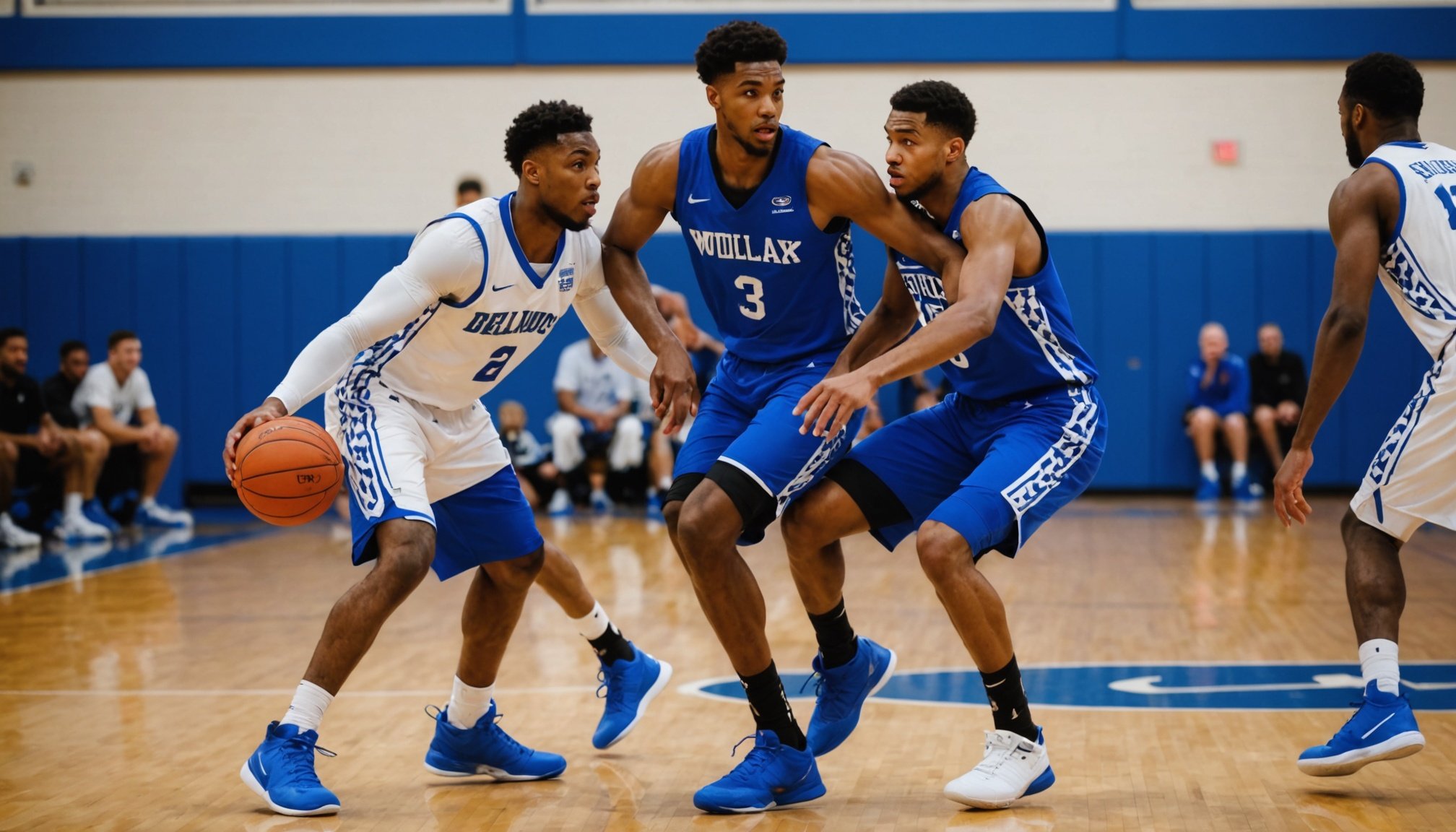Importance of Defensive Drills
In basketball, defense is pivotal, often determining the outcome of a game. It’s in the defensive drills that players hone their skills, preparing for real game situations. Defense isn’t just about stopping the opponent; it’s about possessing the ball and finding opportunities for a counter-attack. This makes defensive drills essential to basketball success and skill development.
Impact of defensive drills on game performance is profound. Players who engage in these drills tend to be more agile, quick, and aware of their surroundings. These athletes anticipate opponent moves better and can adapt swiftly to dynamic game situations. Defensive drills encompass various techniques, including:
This might interest you : Top Plyometric Workouts to Boost Explosive Power for Basketball Centers in the UK
- Footwork enhancement, crucial for maintaining an advantageous position.
- Defensive rebounds, empowering players to regain possession.
Statistical insights reveal that successful teams often have robust defensive strategies. For instance, teams with a higher stop rate generally win more games. This involves calculating the number of times the opponent’s possession is halted without scoring. Through meticulous defensive drills, such teams build formidable defenses, becoming hard to penetrate. Therefore, investing in defensive drills is not merely a part of training but a cornerstone of long-term success in basketball.
Top Defensive Drills for UK Basketball Teams
To equip UK basketball teams with robust defensive capabilities, it is essential to focus on drills that sharpen their tactical edge. Here, we delve into effective basketball drills that reinforce defensive strategies.
Also read : How can a player effectively transition from college basketball to the professional level?
1-on-1 Defensive Drill
The 1-on-1 defensive drill is pivotal for honing individual defensive skills. It emphasizes footwork, agility, and proper body positioning, enabling players to react swiftly to opponents’ movements. Players should maintain a low stance and keep their eyes on the opponent’s torso to anticipate actions. This drill instills confidence in handling one-on-one situations, a critical aspect of effective defense.
Shell Drill
The shell drill is a cornerstone in team defense, focusing on teamwork and communication. By setting up a mock game scenario, players learn how to cover for each other, rotate on screens, and converge towards the ball. This drill not only enhances defensive tactics but also strengthens team cohesion. Coaches should highlight the importance of verbal cues and swift positional adjustments to maximize the drill’s benefits.
Closeout Drill
Practicing the closeout drill is essential for preventing perimeter shots. Players start in a help position and sprint to the shooter, closing the distance while maintaining balance. The goal is to contest the shot without fouling. By consistently executing this drill, players can significantly disrupt the opponent’s shooting rhythm and reduce scoring opportunities. Tips for success include focusing on quick pivots and controlled lunges to challenge shots effectively.
Benefits of Mastering Defensive Drills
Mastering defensive drills brings a host of benefits that are invaluable to any basketball team. At the forefront is the improvement in communication on the court. Effective communication enables players to anticipate each other’s moves, making defensive plays more fluid and coordinated. A well-practiced team can easily switch between defensive strategies without confusion, which is crucial in high-pressure games.
In addition to boosting communication, defensive drills focus on the development of individual and team defense techniques. These drills train players to refine their footwork, positioning, and timing, making each player more adept at anticipating the opponent’s actions. As each player’s skills are enhanced, the entire team’s defensive strength solidifies, bringing the group closer to peak performance.
An often-overlooked advantage is the building of confidence and resilience in players. Facing various offensive threats and mastering the corresponding defensive responses instills a sense of competence. This confidence is crucial during competitive matches where players must rely on their training under stress. Further, the repeated, structured practice of drills cultivates resilience, as players become accustomed to bouncing back swiftly from mistakes, maintaining focus, and adapting strategies on the fly.
By fostering team synergy and skill enhancement, defensive drills transform the defensive line into a formidable force.
Modifications for Different Skill Levels
When it comes to refining techniques in sports, skill level adjustments are crucial. Catering to the varied expertise of athletes ensures efficient and productive training sessions.
Adjustments for Beginners
For newcomers, it’s essential to start with beginner drills that help in grasping fundamental skills without overwhelming them. These real-time exercises often focus on basics like footwork or ball control. To ensure steady improvement, trainers introduce exercises progressively, preventing beginners from becoming discouraged.
Progressive Techniques for Intermediate Players
As players advance, the focus shifts to more progressive techniques. Intermediate players benefit from drills that enhance not only their skills but also decision-making abilities. These sessions introduce more complexity, such as quick transitioning and reactive plays. Training usually requires collaboration with coaching staff to tailor exercises that hit the right level of challenge.
Advanced Strategies for Experienced Teams
Experienced teams require intricate advanced techniques to refine their playstyle. They focus heavily on tactical drills that promote team cohesion and strategic thinking. Here, precision is key. Applying methods from the Stanford Question Answering Dataset (SQuAD) approach promotes strategic gatherings and recalibrations, maximizing the potential of veterans through exact and smart adjustments.
Expert Insights and Recommendations
In the realm of UK basketball, the expertise shared by experienced coaches is invaluable for player development. These professionals offer coaching tips designed to enhance various skills, from fundamental techniques to advanced strategies. Their expert advice often emphasizes the importance of tailored drills that cater to the specific needs and capabilities of players.
Coaches frequently highlight the effectiveness of certain drills through vivid player experiences. For instance, players have reported significant improvements in their agility and shooting accuracy after incorporating these recommended drills into their regular routine. Such testimonials underline the practical benefits of following structured coaching.
Recommendations for integrating drills into practice sessions are diverse but generally align with maximizing efficiency and engagement. Experts suggest starting with a focused warm-up, followed by a rotation of skill-focused activities and ending with a cool-down period. This structure ensures a comprehensive approach to training, allowing players to hone their abilities consistently.
- Warm-up: Engage in light exercises to prepare the body.
- Skill drills: Concentrate on specific areas like dribbling or passing.
- Cool-down: Conclude with techniques to relax and recover.
By implementing these expert-backed strategies, players can not only enhance their performance but also foster a deeper understanding of the game.
Visual and Video Resources
Understanding and mastering new skills in sports often require more than verbal explanations. Visual aids provide an intuitive learning experience by demonstrating the movements and techniques that words alone might not convey effectively.
Diagrams of Key Drills
Diagrams serve as essential training resources that illustrate the fundamental steps and positions needed to perfect various drills. These visual aids help players and coaches alike by laying out clear, step-by-step instructions, ensuring everyone understands the specific techniques involved. Diagrams often highlight critical aspects such as player positioning and movement patterns, allowing for a comprehensive breakdown of complex drills.
Videos Offering Step-by-Step Instructions
For those who prefer dynamic learning, videos deliver detailed drill demonstrations. They provide a visual narrative that combines audio guidance with live-action examples, enabling learners to observe and mimic techniques with precision. Platform recommendations include YouTube and coaching-specific sites, offering extensive libraries of videos tailored to various skill levels and objectives.
Online Resources for Coaches and Players
Incorporating online resources transforms training sessions through accessibility and variety. Websites and apps cater to specific sports, delivering visual aids and instructional videos that enrich coaching sessions. Emphasising visual learning, these resources foster skill development by allowing participants to see techniques in action before practising on the field.











